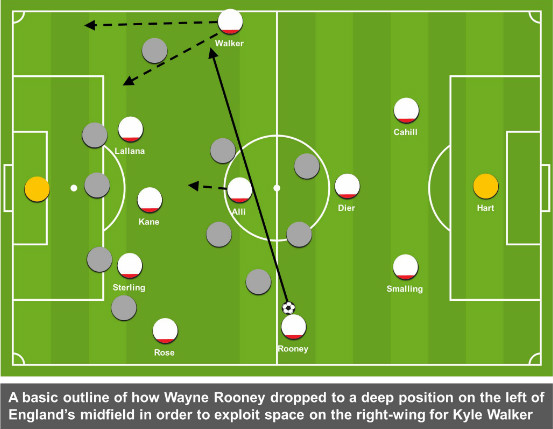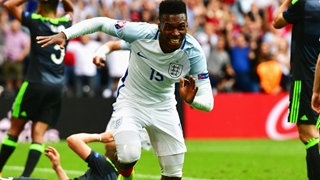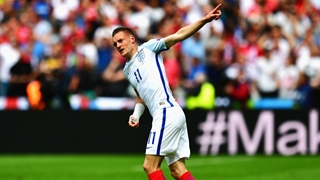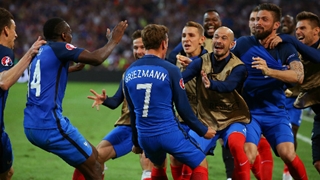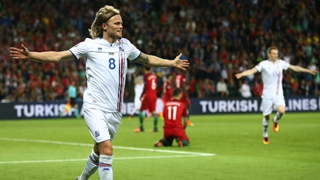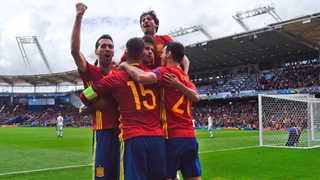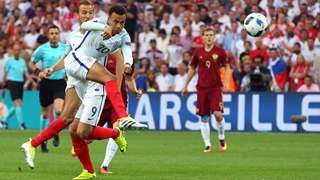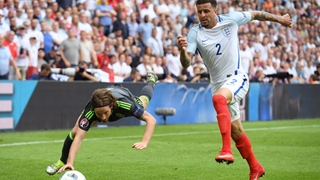
Daniel Sturridge’s added-time winner gave England a late 2-1 victory over Wales as Roy Hodgson’s men secured their first victory of Euro 2016.
Here, FA content editor Peter Glynn picks out a number of positive aspects of the Three Lions’ performance, outlining three discussion points for coaches.
1) Kyle Walker left alone to raid
The importance of attacking full-backs – rather than traditional wingers – in providing width and incision in the final third is fast becoming a key tactical theme in Euro 2016.
Here, England’s Kyle Walker presented a claim for full-back performance of the tournament so far. On countless occasions the Spurs’ defender could be seen galloping down the right of England’s attack providing an outlet for England’s build-up play.
Walker’s raids were effective in both stretching the Wales back five in order to create inside for England’s attackers to dart into as well as negating the potential threat offered by opposition wing-back Neil Taylor going the other way.
Interestingly, England appeared conscious not to clog up Walker’s runway with bodies, allowing the former Sheffield United defender space to exploit in front of him.
In the first half, Adam Lallana’s clever movement infield left Walker alone one-v-one with Taylor. Similarly, in the second period substitute Daniel Sturridge moved infield allowing the right-back to continue to overlap on the outside.
Walker’s performance emphasised the importance of the modern day attacking full-back as a method for providing an incisive threat to congested defences – a tournament trend highlighted in France’s win over Albania on Wednesday.
2) Rooney’s left-sided passing platform
Wayne Rooney – deployed again in midfield – produced another stand-out performance, catching the eye for his use of the ball, varied range of passing and build-up play which linked together England’s back and front units.
Notably, Rooney often wandered to a position deep on the left of the midfield in order to receive the ball from England’s defenders and on occasion found himself positioned on the left-hand touchline.
Rooney’s left-leaning movement was an intelligent strategy. At times, Wales’ midfield three of Joe Allen, Joe Ledley and Aaron Ramsey were uncertain whether to follow the Manchester United man into such a spot. With right wing-back, Chris Gunter, occupied by Raheem Sterling, there was space and time for the England captain exploit.
If the Welsh midfield did leave their shape to press the ball on the left it opened up spaces in central areas for England’s No10 to slide passes inside for the forward runs of Dele Alli who looked to find receiving positions between and beyond the Welsh midfield trio.
Left alone to receive – and with Welsh units shifted to the left – Rooney could use his full repertoire of distribution skills to arrow crossfield passes for the forward runs of Walker [see above] on the opposite flank. This proved a regular and successful feature of England’s game.
Playmaking from wide midfield positions has also been demonstrated by France’s Paul Pogba in the hosts opening game against Romania.
3) Beating the block of defenders: combination play
England are not the first side at this tournament to have to wait until the dying moments before finding a solution to the problem posed by a deep-lying and congested defence.
How to find a way through massed ranks of defenders all of whom are willing to indulge in emergency defending tactics, will continue to be a puzzle for attackers to solve as the tournament progresses.
Here, England’s winning goal saw Sturridge scoop a pass past a crowd of bodies on the edge of the box into the feet of Jamie Vardy.
The clipped forward pass – weighted perfectly beyond the reach of his marker David Edwards – provided the trigger for a third-man run off the ball from Alli who combined with the Leicester City striker before the ball found its way back to Sturridge to roll and prod past Wayne Hennessey in the Wales goal.
It was one of England’s most inventive moments of combination play and was appropriately rewarded with the game’s winning goal.
Peter Glynn is FA Education Content Editor and will be providing comment and analysis throughout Euro 2016.
Peter is editor of The FA’s coaching magazine, The Boot Room, and is a holder of the FA Advanced Youth Award and UEFA B coaching licence.
Follow Peter on twitter: @_peterglynn
*The views expressed in this article are those of the author and not necessarily The Football Association

